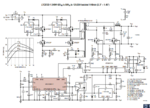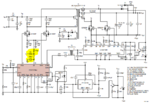bowman1710
Full Member level 3
Hi Guys,
Quick question about this schematic
Looking at the CS signal, for the LTC3723. How have they chosen 15mOhm total resistance for the current sense signal? How i see it is that the device has a limit of 280mV with that being so, 280mV/15mOhm=18A or so. I haven't done a lot of current sense work so I guess that duty cycle will effect it but cant see any stuff on-line about choosing the right value apart from what I have done above. But if that is how you do it, why does it work out to around 18A when at most the primary will be 6-7A or so?

Quick question about this schematic
Looking at the CS signal, for the LTC3723. How have they chosen 15mOhm total resistance for the current sense signal? How i see it is that the device has a limit of 280mV with that being so, 280mV/15mOhm=18A or so. I haven't done a lot of current sense work so I guess that duty cycle will effect it but cant see any stuff on-line about choosing the right value apart from what I have done above. But if that is how you do it, why does it work out to around 18A when at most the primary will be 6-7A or so?


